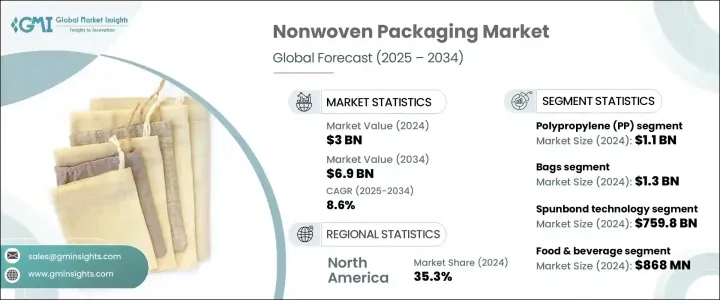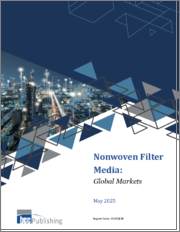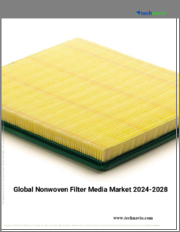
|
시장보고서
상품코드
1716715
부직포 포장 시장 기회, 성장 촉진 요인, 산업 동향 분석, 예측(2025-2034년)Nonwoven Packaging Market Opportunity, Growth Drivers, Industry Trend Analysis, and Forecast 2025 - 2034 |
||||||
세계의 부직포 포장 시장은 2024년에 30억 달러에 이르렀으며 2025년부터 2034년까지 8.6%의 견고한 CAGR로 성장할 것으로 예측됩니다.
전자상거래의 급증, 소매 부문의 급성장, 지속 가능한 패키징 솔루션에 대한 소비자 수요 증가가 이 확대를 뒷받침하고 있습니다. 이에 따라 친환경 대체품을 우선하게 되고 있습니다. 플라스틱 폐기물을 대상으로 한 정부의 규제가 강화되는 가운데, 제조업체는 생분해성으로 재활용 가능한 부직포 소재를 개발하는 것으로 혁신을 도모하고 있습니다.

환경에 대한 의식이 높아짐에 따라 패키징 업계의 정세를 바꾸고 있으며, 업계는 순환 경제의 원칙에 따른 대체품을 요구하고 있습니다. 부직포 패키징 솔루션을 생산하기 위해 첨단 소재와 생산 기술에 투자하고 있습니다. 부직포 가방, 랩, 파우치에 대한 선호도가 증가하는 이유는 비용 효율성과 탄소 발자국 감소 능력 때문입니다. 또한, 소매업체나 E-Commerce 대기업은 효율적인 출하와 제품 보호를 확보하면서 지속가능성 목표를 달성하기 위해서, 이러한 소재에 시프트하고 있습니다.
| 시장 범위 | |
|---|---|
| 시작 연도 | 2024년 |
| 예측 연도 | 2025-2034년 |
| 시작 금액 | 30억 달러 |
| 예측 금액 | 69억 달러 |
| CAGR | 8.6% |
폴리프로필렌(PP) 소재 분야가 시장을 선도하고, 2024년에는 11억 달러에 달했습니다. 건강 및 개인 관리 제품에 대한 수요가 증가함에 따라 항균성, 경량성, 내습성 등의 특성으로 인해 폴리프로필렌의 사용을 가속화하고 있습니다.
시장 세분화는 제품 유형별로 가방, 랩, 가방 등으로 구성되며 가방의 2024년 매출은 13억 달러였습니다. 이러한 재사용 가능하고 재활용 가능한 옵션은 엄격한 환경 규제와 진화하는 소비자의 선호도와 일치합니다.
북미는 2024년 부직포 포장 시장의 35.3% 점유율을 획득하여 이 지역의 재활용 가능하고 내구성 있는 포장재료에 대한 강한 수요로 우위성을 유지하고 있습니다. 적극적인 노력이 지속 가능한 대체품으로의 시프트를 가속화하고 있습니다. 다양한 산업에서 부직포 포장이 널리 채용되고 있기 때문에 북미가 세계의 환경 목표에 따른 지속 가능한 포장 솔루션의 개척으로 리더십을 발휘하고 있는 것을 알 수 있습니다.
목차
제1장 조사 방법과 조사 범위
제2장 주요 요약
제3장 업계 인사이트
- 생태계 분석
- 업계에 미치는 영향요인
- 성장 촉진요인
- 지속 가능한 포장에 대한 수요 증가
- 비용 대비 효과와 높은 생산 효율
- 전자상거래와 소매 업계의 성장
- 음식 및 식품 산업 확대
- 헬스케어 및 의약품에 있어서의 채용 증가
- 업계의 잠재적 위험 및 과제
- 높은 초기 생산 비용과 유지 보수 비용
- 소비자의 인식과 채용이 한정적
- 성장 촉진요인
- 성장 가능성 분석
- 규제 상황
- 기술 상황
- 향후 시장 동향
- 갭 분석
- Porter's Five Forces 분석
- PESTEL 분석
제4장 경쟁 구도
- 소개
- 기업 점유율 분석
- 주요 시장 기업의 경쟁 분석
- 경쟁 포지셔닝 매트릭스
- 전략 대시보드
제5장 시장 추정 및 예측 : 재료 유형별, 2021년-2034년
- 주요 동향
- 폴리프로필렌(PP)
- 폴리에틸렌(PE)
- 폴리에스테르(PET)
- 레이온
- 기타
제6장 시장 추정 및 예측 : 제품 유형별, 2021년-2034년
- 주요 동향
- 가방
- 랩
- 파우치
- 기타
제7장 시장 추정 및 예측 : 기술별, 2021년-2034년
- 주요 동향
- 스펀본드
- 멜트블로운
- 에어레이드
- 젖은 레이드
- 니들 펀치
- 기타
제8장 시장 추정 및 예측 : 최종 용도별, 2021년-2034년
- 주요 동향
- 음식
- 헬스케어
- 소비재
- 공업
- 농업
- 소매
- 기타
제9장 시장 추정 및 예측 : 지역별, 2021년-2034년
- 주요 동향
- 북미
- 미국
- 캐나다
- 유럽
- 독일
- 영국
- 프랑스
- 스페인
- 이탈리아
- 네덜란드
- 아시아태평양
- 중국
- 인도
- 일본
- 호주
- 한국
- 라틴아메리카
- 브라질
- 멕시코
- 아르헨티나
- 중동 및 아프리카
- 사우디아라비아
- 남아프리카
- 아랍에미리트(UAE)
제10장 기업 프로파일
- Agritex
- Ahlstrom
- Andritz
- Aster
- Benz Packaging
- CK Fabrics
- Felix Nonwovens
- Jayashree Spun Bond
- PakFactory
- Pratrivero
- ProAmpac
- Thrace Group
- Toray Industries
The Global Nonwoven Packaging Market reached USD 3 billion in 2024 and is projected to expand at a robust CAGR of 8.6% from 2025 to 2034. The surge in e-commerce, rapid growth in the retail sector, and increasing consumer demand for sustainable packaging solutions are driving this expansion. Businesses and consumers alike are prioritizing environmentally friendly alternatives as the global push toward sustainability gains momentum. With stricter government regulations targeting plastic waste, manufacturers are innovating by developing biodegradable and recyclable nonwoven materials.

Rising environmental awareness is reshaping the packaging landscape, with industries seeking alternatives that align with circular economy principles. Major players are investing in advanced materials and production technologies to create lightweight, durable, and reusable nonwoven packaging solutions. The growing preference for nonwoven bags, wraps, and pouches stems from their cost-effectiveness and ability to reduce carbon footprints. Additionally, retailers and e-commerce giants are shifting towards these materials to meet sustainability targets while ensuring efficient shipping and product protection. The increasing adoption of nonwoven packaging across healthcare, food and beverage, and personal care industries further strengthens market growth, positioning it as a vital segment in the global packaging sector.
| Market Scope | |
|---|---|
| Start Year | 2024 |
| Forecast Year | 2025-2034 |
| Start Value | $3 Billion |
| Forecast Value | $6.9 Billion |
| CAGR | 8.6% |
The polypropylene (PP) material segment led the market, generating USD 1.1 billion in 2024. Its versatility and cost-effectiveness make it a preferred choice for producing packaging products such as bags, wraps, and protective covers. The rising demand for health and personal care products is accelerating the use of polypropylene due to its antimicrobial, lightweight, and moisture-resistant properties. The spunbond technology, widely utilized in nonwoven production, continues to boost the segment's growth, enhancing the durability and efficiency of packaging solutions.
Market segmentation by product type includes bags, wraps, sachets, and others, with the bags segment accounting for USD 1.3 billion in revenue in 2024. Retailers and grocery chains are increasingly adopting nonwoven bags as an eco-friendly alternative to traditional plastic bags. These reusable and recyclable options align with stringent environmental regulations and evolving consumer preferences. The rapid expansion of e-commerce is further driving demand for nonwoven packaging, ensuring secure, lightweight, and sustainable shipping solutions.
North America captured a 35.3% share of the Nonwoven Packaging Market in 2024, maintaining its dominance due to the region's strong demand for recyclable and durable packaging materials. Government policies supporting eco-friendly packaging and aggressive initiatives to phase out single-use plastics are accelerating the shift toward sustainable alternatives. The widespread adoption of nonwoven packaging across various industries highlights North America's leadership in pioneering sustainable packaging solutions that align with global environmental goals.
Table of Contents
Chapter 1 Methodology and Scope
- 1.1 Market scope and definitions
- 1.2 Research design
- 1.2.1 Research approach
- 1.2.2 Data collection methods
- 1.3 Base estimates and calculations
- 1.3.1 Base year calculation
- 1.3.2 Key trends for market estimation
- 1.4 Forecast model
- 1.5 Primary research and validation
- 1.5.1 Primary sources
- 1.5.2 Data mining sources
Chapter 2 Executive Summary
- 2.1 Industry 3600 synopsis
Chapter 3 Industry Insights
- 3.1 Industry ecosystem analysis
- 3.2 Industry impact forces
- 3.2.1 Growth drivers
- 3.2.1.1 Rising demand for sustainable packaging
- 3.2.1.2 Cost-effectiveness & high production efficiency
- 3.2.1.3 Growth in e-commerce & retail industry
- 3.2.1.4 Expanding food & beverage industry
- 3.2.1.5 Increasing adoption in healthcare & pharmaceuticals
- 3.2.2 Industry pitfalls and challenges
- 3.2.2.1 High initial production and maintenance cost
- 3.2.2.2 Limited consumer awareness & adoption
- 3.2.1 Growth drivers
- 3.3 Growth potential analysis
- 3.4 Regulatory landscape
- 3.5 Technology landscape
- 3.6 Future market trends
- 3.7 Gap analysis
- 3.8 Porter's analysis
- 3.9 PESTEL analysis
Chapter 4 Competitive Landscape, 2024
- 4.1 Introduction
- 4.2 Company market share analysis
- 4.3 Competitive analysis of major market players
- 4.4 Competitive positioning matrix
- 4.5 Strategy dashboard
Chapter 5 Market Estimates and Forecast, By Material Type, 2021 - 2034 (USD Billion & Kilo Tons)
- 5.1 Key trends
- 5.2 Polypropylene (PP)
- 5.3 Polyethylene (PE)
- 5.4 Polyester (PET)
- 5.5 Rayon
- 5.6 Others
Chapter 6 Market Estimates and Forecast, By Product Type, 2021 - 2034 (USD Billion & Units)
- 6.1 Key trends
- 6.2 Bags
- 6.3 Wraps
- 6.4 Sachets
- 6.5 Others
Chapter 7 Market Estimates and Forecast, By Technology, 2021 - 2034 (USD Billion & Kilo Tons)
- 7.1 Key trends
- 7.2 Spunbond
- 7.3 Meltblown
- 7.4 Airlaid
- 7.5 Wetlaid
- 7.6 Needle punch
- 7.7 Others
Chapter 8 Market Estimates and Forecast, By End Use, 2021 - 2034 (USD Billion & Kilo Tons)
- 8.1 Key trends
- 8.2 Food & beverage
- 8.3 Healthcare
- 8.4 Consumer goods
- 8.5 Industrial
- 8.6 Agriculture
- 8.7 Retail
- 8.8 Others
Chapter 9 Market Estimates and Forecast, By Region, 2021 - 2034 (USD Billion & Units)
- 9.1 Key trends
- 9.2 North America
- 9.2.1 U.S.
- 9.2.2 Canada
- 9.3 Europe
- 9.3.1 Germany
- 9.3.2 UK
- 9.3.3 France
- 9.3.4 Spain
- 9.3.5 Italy
- 9.3.6 Netherlands
- 9.4 Asia Pacific
- 9.4.1 China
- 9.4.2 India
- 9.4.3 Japan
- 9.4.4 Australia
- 9.4.5 South Korea
- 9.5 Latin America
- 9.5.1 Brazil
- 9.5.2 Mexico
- 9.5.3 Argentina
- 9.6 Middle East and Africa
- 9.6.1 Saudi Arabia
- 9.6.2 South Africa
- 9.6.3 UAE
Chapter 10 Company Profiles
- 10.1 Agritex
- 10.2 Ahlstrom
- 10.3 Andritz
- 10.4 Aster
- 10.5 Benz Packaging
- 10.6 CK Fabrics
- 10.7 Felix Nonwovens
- 10.8 Jayashree Spun Bond
- 10.9 PakFactory
- 10.10 Pratrivero
- 10.11 ProAmpac
- 10.12 Thrace Group
- 10.13 Toray Industries













